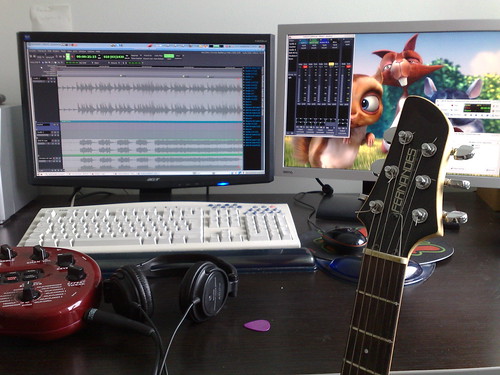I’m done with posting for this week as it’s time to overhaul my (very, very humble) apartment studio space and gear closet. But that seems the perfect time to ask you how you set up your musical workspace. (I think people imagine that I have rooms full of gear, but I really do a lot of work in-box on computer, which I’m gradually augmenting with some “boutique” – but reasonably affordable – DIY synth boxes. As an urbanist and someone on a limited budget with limited space, that works well.)
I’m a great fan of Lifehacker’s ongoing series on their readers’ workspaces, which show off marvels of productivity, efficiency, and attractive interior design:
Lifehacker Workspace Show and Tell [Flickr]
For some of the best examples: http://lifehacker.com/tag/workspace/
It’s funny; the notion of “bedroom producers” is often disparaged, but I think the ability to have personal workspaces are a great thing for music. Now, a musical workspace can range from an impromptu setup on a hotel room desk to a corner of an apartment to a space you’ve built in a barn to a traditional studio. Each of those locations has its own advantages (and in a way, make you appreciate what’s special about the conventional studio even more).
So, whether you’ve worked out a mobile rig with a Nintendo DS and a tape recorder or you’ve got a dream studio you get to work in — or you want to show off how you’ve managed to organize your closet full o’ gear and cables — we’d love to hear from you. Send us a link to a public gallery in comments, or upload to CDM’s Flickr pool:
http://www.flickr.com/groups/cdmu/pool/
Also, do us a favor. Either send a note explicitly allowing us to reproduce your image, or even better, license your photo on Flickr as Creative Commons ShareAlike. (Because CDM runs ads against content, we apparently do not qualify as a non-commercial use. ShareAlike, though, means that anyone using your content also needs to share their content, which helps protect against exploitation.) You can add the license directly on Flickr, and then it’s more likely that we can use your images. I’ve actually thought of doing regular round-ups of images on Flickr, but getting individual licenses would be too time-consuming; if people do start doing this, I will easily feature the images you’re sending in!
I’m really eager to see your musical environments. Part of the joy of music is that ability to take your mind and spirit to another place, and that means setting aside physical space. (I recall a Buddhist friend of mine and the importance that had for where he would chant. It wasn’t anything extravagant, just a decision to set aside a location for the activity.)
To kick things off, Thomas Dolby has the location most of us would dream of: he’s got a wind- and solar-powered restored lifeboat on the north coast of England.
Dolby talks about his studio and the ideas behind it, followed by a new song he wrote in the boat, at TED:
Keyboard Magazine took a tour of the boat and covers all the gear contained onboard):
On Board Thomas Dolby’s Solar Studio Boat
More photos at Tiny House Design
But I’d love to see your less-exotic music making locations, too.
